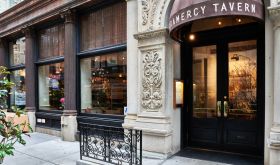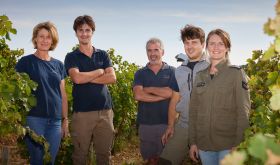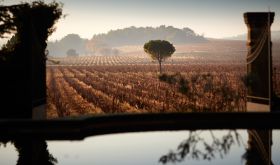On our second visit to San Sebastian this year, this time to celebrate a significant family birthday, a couple of specific reasons became obvious for this historic city’s plethora of exciting places to eat and drink, only a handful of which are described below.
The first hit me as we emerged from the underground car park below the Hotel Niza right on the sea front. There was an immediate tang at the back of my throat as the salty wind blew in across the bay from the Atlantic, whetting both my appetite and desire for that first glass of Txakoli, the local, young, slightly sparkling wine, and for a plate of almonds and ham, or two. If it’s the ozone and Txakoli that peps up the appetite, it’s this constant sea breeze which keeps the beach bearable even when the thermometer reads 36 degrees in early September.
The second was the sight of hordes of locals walking strenuously along the beach, right by the sea, round the full mile or so of the crescent-shaped sand. It is an extraordinary sight, reminiscent of shoppers in London’s Oxford Street, but all of them are wearing next to nothing and looking relaxed. They really pound that shore obviously appreciating the pleasure of lunch or dinner nearby when they have walked their allotted number of kilometres, many deep in conversation putting their world to rights. It is also rare to see so many Spaniards without their mobile phones, although I did see one woman with hers firmly wedged into the top of her bikini.
The specific goals of our trip were, at our son’s request, to eat at Martin Berasategui’s restaurant in Lasarte, a 15 minute taxi ride out of town, and to raid the wine cellar at Rekondo, a 20 minute walk from the Niza (although I think that the latter had a little to do with keeping his mother happy). But San Sebastian had another restaurant surprise in store, we were to discover.
It is hard to categorise the style of food and service at Martin Berasategui’s top restaurant. It bears all the hallmarks of a three-star Michelin restaurant with Relais & Chateaux plaques on the wall, but the style of service is so much less formal and more friendly than the stereotype. And so too was the food. It is unquestionably experimental, dramatic and exciting placing Berasategui right up alongside Ferran Adria, the Roca brothers at El Celler de Can Roca in Girona and his Sam Sebastian neighbour Juan Mari Arzak, but at the same time his menu, and therefore your meal, are much more structured, an approach which won compliments even from our 14 year old daughter who is not, yet, the most experimental eater in the family.
Perhaps the best example of this came when in the face of five people who could not decide on what to eat, the multi-lingual maitre d’ suggested that we choose half portions of what we fancied thereby enabling us to pick from both the fish and meat sections – although when these dishes arrived it did appear that they were more like 75 per cent of the real thing, such is the generosity of the kitchen.
Highlights included a small bowl of beetroot essence topped with a circle of cockles and flecks of what was surely the freshest parsley in the world; a small ball of squid ravioli that oozed squid ink as it hit the back of the mouth (our son ate three of the five served to our table); a cool fennel soup with the most succulent freshwater prawns from Motril in southern Spain; a stunning rendition of the classic Basque dish of hake cheeks, wonderfully gelatinous, but here served with a much lighter parsley sauce than usual; and two very different desserts: a rich chocolate soufflé and a much more refreshing dish of strawberries marinated in our old friend Txakoli.
A walk round the atmospheric old town that afternoon to buy cigars had convinced me that the right approach to Saturday lunch would be a sortie round the area’s numerous tapas bars where the counters are piled high with raciones and the ceilings are strung with legs of ham. But I was merely the person with the credit card in my pocket so what say did I have in all this? And as our son pointed out as we, in the end, headed towards the old town but to a table he had booked at Bodegón Alejandro, Martin Berasategui’s newer and much less expensive taverna, Saturday lunch is my favourite meal of the week so we really should be enjoying it in style. Which is exactly what we did.
Bodegón Alejandro is easy to find, down the road to the right of the city’s bustling Central Market and then second left, then down a flight of stairs on the right. As we made our way down, the cool of the cellar came as a great relief and my appetite was whetted by the old black and white photos of weightlifters along the walls – somehow there is nothing like the sight of someone else trying to lift a 200kg dead weight to make you want to concentrate on the menu and wine list.
The interior is homey and only two words of caution need to be offered about anyone planning to visit: by the end of our meal the restaurant had become quite warm and we looked on with envy at one Spanish woman who had wisely brought along her fan and the two dining rooms are tiled to shoulder height so I would imagine when the restaurant is full it is also pretty noisy.
But the food is terrific and the pricing exceptional – 29.50 euros for three substantial and beautifully executed courses which, naturally, came with an amuse bouche of a shot of a creamy gazpacho and at the end a shot of a ‘rice pudding liqueur’ similar to the shot of milk and Armagnac served at his posh restaurant and small, warm almond cakes. What came in between was extremely impressive too, great value and showed Berasategui’s expertise at combining the more traditional Basque dishes with his young brigade’s desire to innovate.
We began with two small dishes, one of warm, satisfying croquetas, the other of a large white square platter with rows of halved, sautéed red piquillo peppers with diced garlic that were delicious. Then a soothing dish of ceps and scrambled eggs; creamy rice with cuttlefish; a large mound of tempura vegetables; and wild mushroom ravioli in a creamy potato sauce. Most outstanding among the main courses were some small cuttlefish in its ink and three cubes of sautéed polenta standing guard between two halves of duck breast with a foie gras ravioli. All the desserts were sensational but most memorable were a thick slice of French toast filled soaked in cream and honey and then caramelised and served warm with the local speciality, cream cheese ice cream, and what was described as junket ‘made at your table’. On a white rectangular dish in front of me was a jug with a thin layer of rennet along the bottom next to a jug of warm milk and a jar of what appeared to be the purest, most unadulterated honey. My waitress told me to pour the milk on to the rennet and to wait a couple of minutes after which it had naturally set leaving me to pour honey all over it and then to finish it off without letting anyone else stick their spoon in. If all this was not strictly the best preparation for dinner at Rekondo, it did make for a great siesta.
Digestion was, however, helped by a swift, steep walk under an increasingly gloomy sky along the now deserted beach and up the hill that leads out of the town by the furnicular. Arriving at 21.30, we found Rekondo looking very different from when we had lvisited there last February and we had been the first to arrive by about 40 minutes for lunch at 13.00. There were diners outside sitting at tables under the trees by the entrance and there seemed to be definite signs of the kitchen trying to shake off its traditional past: the pickled partridge came in a bowl with twirls around the rims, as did the very filling fillets of venison. But other dishes have not changed at all and I, for one, hope they never will, most notably the baked spider crab, the clams with rice, the hake cheeks and best of all what is described on the menu as the ‘beef chop’, the rib of beef cooked on the open fire grill by the proud Txomin Rekondo, which packed fantastic flavour and accentuated the charms of a fully mature, sweet Pignan 1996, a steal at 80 euros (there are another four vintages on the list, too, at no more exorbitant prices).
Most importantly, the wine list has barely changed since our first visit with as many fascinating wines to choose from at as ridiculously low prices. We began with a 2001 Bienvenue Batard Montrachet from Ramonet at 90 euros that was very full, creamy and powerful with good length and a good future ahead of it and ended with a half of honeyed Marcel Deiss’s Altenberg Gewurztraminer Selection des Grains Nobles 1996 for 40 euros. The main difference in the list since February is that there is no more of the Ornellaia recommended so heartily on this website earlier this year.
The family-run Rekondo is fun not just because of the wine bargains that await and, having seen the size of the cellar built up by father and maintained by daughter, should continue for many a year, but because it still maintains the old world charm of a Basque restaurant from a previous era. And there is the added bonus of a good walk, downhill this time, with all that great wine inside you.
Anyone who has made it through this far will doubt that the last thing we deserved before flying home from Biarritz airport was another good meal. But thanks to the recommendation of Madrid-based journalist and wine maker Victor de la Serna, we found ourselves the following day sitting down on the terrace of Le Bayonnais in Bayonne overlooking the river with another appetising menu to hand. With its vies of rather Quai des Chartrons-like old merchants' houses, this no more than 20 minutes from the airport and is infinitely preferable to, and not that much more expensive than, Ryanair's longlife inflight offerings.
The transition from eating out in Spain to the same activity France is quite a shock when crossing the national border between these two countries is quite so swift. We had been firmly told that last orders are at 13.30, at least half an hour before most Spanish restaurants are open, and when we arrived just after 13.00 most of the tables were taken and we were certainly the youngest party there. Sunday lunch at Le Bayonnais certainly seems the place for the local, knowledgeable bourgeoisie.
Knowledgeable because Le Bayonnais, which belongs to Monsieur et Madame Pascal with Christophe in the kitchen, may not look exceptional but is a really well run establishment which delivers great flavours in all its dishes. The day’s special card enticingly included squid a la plancha, a fillet of cod with ceps and a pastilla of figs, of which the latter two were outsanding. So too was the local Bayonne ham from Maison Codéga, of which there were six generous slices for 10 euros; two pieces of very well prepared foie gras with spiced apricot compote for the same price; and some lamb cutlets under a mound of runner beans. In true French tradition, your order for dessert is taken at the beginning of the meal so there is no way of passing on really excellent îles flottantes or the rich chocolate cake with vanilla ice cream. With a bottle of the local Irouléguy, a floral, fruity, ultra-tangy 2003 from Domaine Brana, our bill for an exceptional lunch for five came to 229 euros.
Perhaps after all this we should have walked to the airport but we didn’t.
Martin Berasategui, Loidi 4, Lasarte, Spain tel +34 943 36 64 71
Bodegón Alejandro c/Fermin Calbeton 4, San Sebastian, Spain tel +34 943.427.158. Closed Sunday evening, Monday and Wednesday evening other than in July and August.
Rekondo. Paseo de Igueldo 57, San Sebastian, Spain tel +34 943. 21.29.07, www.rekondo.com
Restaurant Le Bayonnais, 38 Quai des Corsaires, 64100 Bayonne, France
Tel +33 05.59.25.61.19













